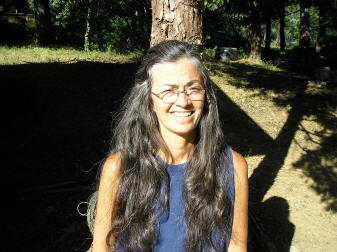


 Where is a poet born
Where is a poet born
BY LINDA TOREN
Where is a poet born, if not in a place? Perhaps by invitation … My sixth grade teacher explained the form of haiku and then the assignment to write one. I must have considered it an invitation more than an assignment because I wrote my first poem: Lonely people live/ within themselves like dusty/ books upon a shelf. Poetry reading and writing proceeded from that true moment. Much later, I became a “licensed fool” by invitation. What sustains a poet? It must be hanging around with other poets - reading poetry, listening to the other poets sing.
I was born in San Francisco, grew up south of there, went to SF State, and became an entomologist working at the California Academy of Sciences. Even so, poetry framed my work as I realized Aldo Leopold, Rachel Carson, and Loren Eisley could think of no better way to describe the natural world than by verse and poetic prose. In those years, I worked my way through school doing environmental impact reports in the Bay Area. I found out biodiversity does not do well in the face of human expansion and politics.
I moved to the foothills almost thirty years ago, raising a family and teaching at a small rural school. When I became a teacher, science and literature intertwined. For the last three years I have been writing a haiku a day for my students. It is a perfect way to begin. I describe what caused the poem to happen and then read it for meaning – how breath and pauses make all the difference. Students love to try their hand reading the poems aloud. Since haiku are so intimately connected to the natural world, these daily poems seem to be a perfect way of reminding us to look closely, look far and look within.
Blue moon fades from full,
silver tipping into view –
a new month of light.
My rooster yodels,
learning his song again and
again until it’s right.
Fair day, blue sky, sun …
this might be the one true day
to find perfection.
This year, my third grade students are part of a watershed project along a tributary of the Mokelumne River. We will check for animal and plant diversity, water quality, and changes through the seasons of the year. We will paint pictures using water from the river and write a report of our findings. We will also be writing poetry in order to capture the heart of the place along with the science.
Another project, dear to my heart, will continue since we received a grant from the Native Culture Fund to work on preserving Mi-wuk language last year. Students and I made a pictionary of Mi-wuk language in 1992. Now, with the help of Mi-wuk adults and the few native speakers left, we hope to preserve not only the names of animals and plants in Mi-wuk but also some of the poetry and flow of conversation.
To Keep the World From Falling Apart
Dragonflies knit a stillness
over bullfrog’s eyes.In the green-brown water
their larvae shed dust-colored armor
along sedge stems, their crisp coats
translucent by day, opaque by night.There is a nest deep in the cattails,
Bowled over with grasses and Queen Anne’s Lace.
Later, a goose will bring her goslings out in the open,
present them to swollen willow buds,
make her offering of life to the blackberries –
not knowing how they stain.Little flies spiral at the pond surface
near enough to kiss it, and they do.22 May 2001
Fall Walk
Woodpecker:
grounded
its little red cap
just so
alert
turning toLiquid amber:
the science
of transformation
secret to the naked eye
but slowly
just so
beautiful
in turn
Soil:
waits
to heave up
remembering
the strength of frost
which can grab water
out of thin air
placing cold daggers
painlessly
just so.20 October, 2001
Equinox
Equal hours hum
in the dark and light
of acceptance.I balance
one hand empty
the other full of green.My bones become
bird bones, shot with air,
ready to fly …ready to breathe
inside any rising hymns,
inside the space where
light leaves stars behind.
Linda Toren
21 March 2004
![]()
